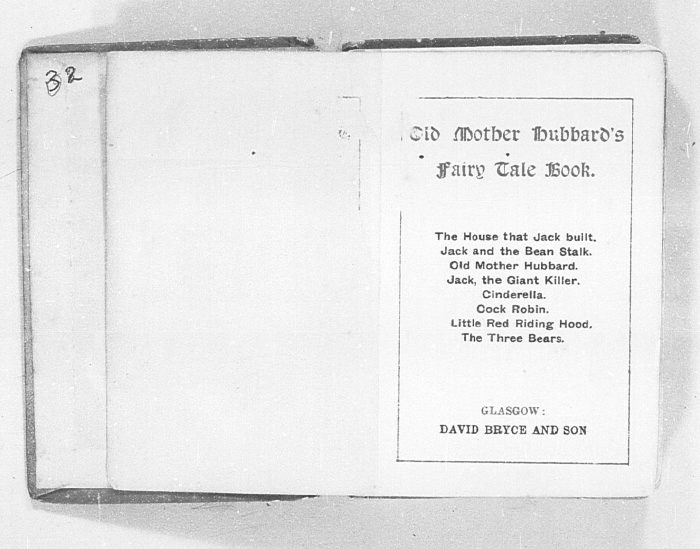Fables and Fairy Tales. 0032: Anon., Old Mother Hubbard's Fairy Tale Book
| Author: |
Anon. |
| Title: |
Old Mother Hubbard's fairy tale book. The House that Jack Built. Jack and the Beanstalk. Old Mother Hubbard. Jack the Giant Killer. Cinderella. Cock Robin. Little Red Riding Hood. The Three Bears. |
| Cat. Number: |
0032 |
| Date: |
No date but c.1860? |
| 1st Edition: |
|
| Pub. Place: |
Glasgow |
| Publisher: |
David Bryce and Son |
| Price: |
Unknown |
| Pages: |
1 vol., 128pp. |
| Size: |
9 x 6 cm |
| Illustrations: |
|
| Note: |
Inscription on fly-leaf: 'Dorothy Mallows' |
Images of all pages of this book

Introductory essay
The fairy tales included in this collection differ to various degrees from the standard versions. In 'Little Red Riding Hood', for instance, not only is the wolf slain by the 'green huntsman', but there is a fairly substantial of the tale still to run. Running out of her grandmother's cottage, Red Riding Hood follows an 'old crone'. She turns out to be a fairy, who congratulates Red Riding Hood for her many kindnesses earlier in the story. It was only because she had helped a water-cress woman and been kind to a wasp and a tom-tit, we learn, that the huntsman had arrived in time to shoot the wolf (see pp.114ff.).
In 'The Three Bears', the heroine is 'Silver-hair' rather than the more familiar 'Goldilocks'. In the earliest surviving versions of the tale, including what was probably the first printed edition, by Robert Southey in 1837, the 'heroine' of the tale had usually been described as a little old woman. It was Joseph Cundall's Treasury of Pleasure Books for Young Children of 1850 which first introduced 'Silver-hair', a name which remained in the tale for some time. 'Goldilocks' seems to have made her appearance only in Old Nursery Stories and Rhymes in c.1904 (Carpenter 1984: 524). This collection probably dates from sometime in the second half of the nineteenth century therefore.
Carpenter, Humphrey & Pritchard, Mari, The Oxford Companion to Children's Literature, Oxford: OUP, 1984



